Table of Contents
- Introduction
- Editor’s Choice
- Extended Reality Statistics by Market Size
- Extended Reality Statistics By Regional Market Breakdown
- AR Market Size and Growth
- Top AR Companies
- Virtual Reality (VR) Statistics
- Mixed Reality (MR) Statistics
- Extended Reality Statistics by Gaming Sector
- Extended Reality in Healthcare Statistics
- Extended Reality in Education Statistics
- Retail and E-commerce Extended Reality Statistics
- Extended Reality in Real Estate Statistics
- Extended Reality Statistics Latest Technology Trends
- Recent Developments
- Conclusion
- FAQs
Introduction
Extended Reality Statistics: Extended Reality (XR) is a wide-ranging category. It encompasses Augmented Reality (AR), Virtual Reality (VR), and Mixed Reality (MR) technologies. Each has a profound impact on our perception of reality.
AR superimposes digital content onto the physical world. VR immerses users in entirely digital realms, and MR seamlessly merges the digital with the physical.
These technologies have diverse applications in entertainment, education, healthcare, industry, retail, and real estate.
Fundamentally transforming how we engage with these domains and enhancing efficiency. Yet, XR faces challenges, including privacy concerns and technical limitations.
Looking ahead, XR’s future is marked by its integration with 5G technology. More lifelike simulations, and deeper integration into our everyday lives. Promising a significant transformation in our interactions with the world.
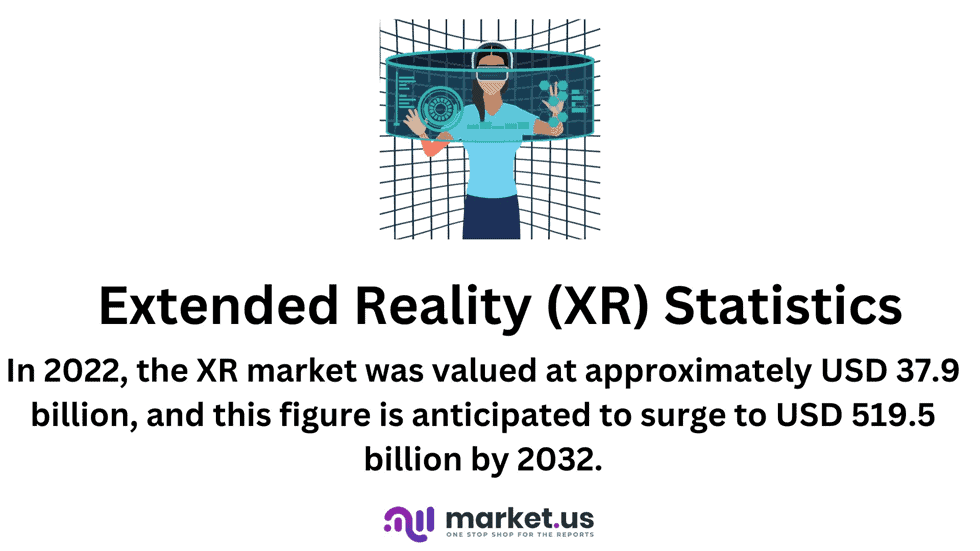
Editor’s Choice
- The Global Extended Reality (XR) Market size is expected to be worth around USD 519.5 Billion by 2032
- From USD 49.6 Billion in 2023, Growing at a CAGR of 30.8% during the forecast period from 2024 to 2033.
- In 2022, the XR market was valued at approximately USD 37.9 billion. Which is anticipated to surge to USD 519.5 billion by 2032.
- The market is experiencing remarkable growth at a CAGR of 30.8%.
- In 2020, global expenditure on Augmented Reality (AR) and Virtual Reality (VR) was projected to reach 12 billion US dollars. This figure is anticipated to increase substantially, reaching 72.8 billion US dollars by 2024.
- Augmented Reality technology finds applications in various sectors. Such as healthcare, public safety, tourism, marketing, and the gas and oil industry.
- On the other hand, in 2020, Virtual Reality saw its most significant usage in VR gaming and VR video among consumers.
- In 2020, approximately 100 million shoppers used AR for their shopping needs. A staggering 1 billion people worldwide engaged with AR somehow.
- In the United States alone, about 83.1 million consumers incorporated AR into their monthly routines.
- Remarkably, 70% of individuals aged 16 to 44 were aware of AR.
- However, by the end of 2022, AR usage among consumers in the United States decreased to 17%.
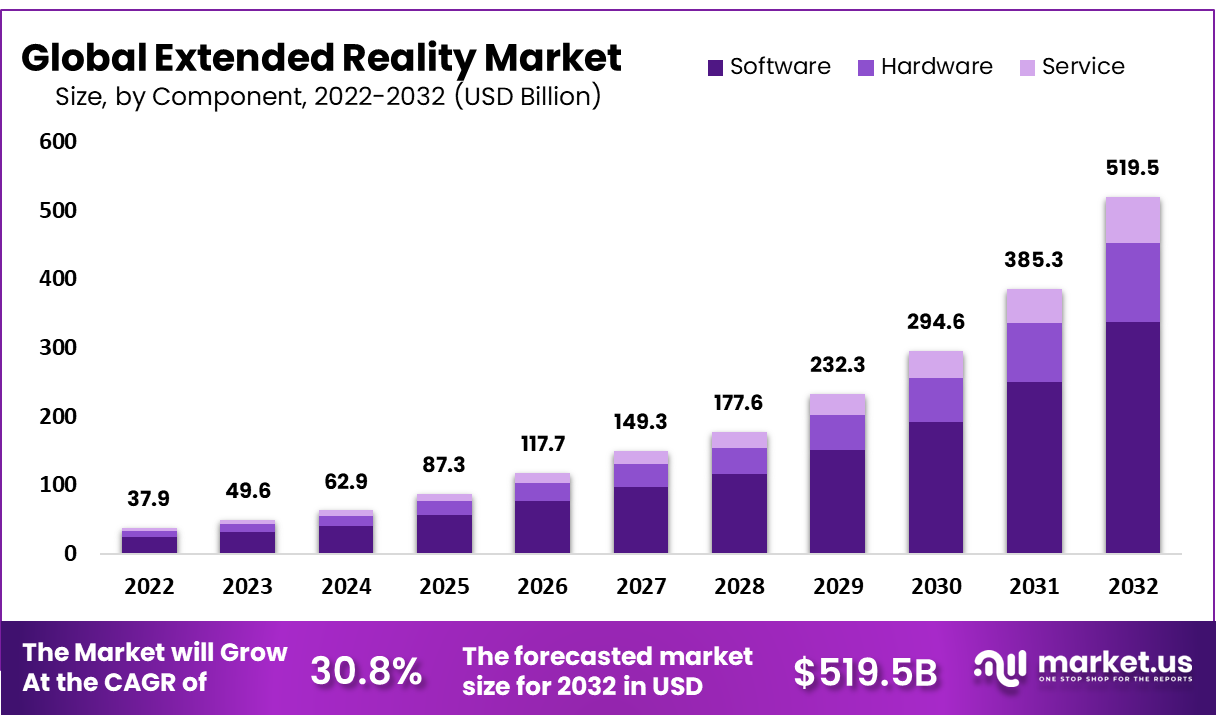
Extended Reality Statistics by Market Size
- The extended reality (XR) market is experiencing remarkable growth at a CAGR of 30.8%. With a steady increase in market size projected over the next decade.
- In 2022, the XR market was valued at approximately USD 37.9 billion. This figure is anticipated to surge to USD 49.6 billion in 2023, reflecting a substantial year-over-year growth rate.
- The growth trajectory continues to be promising, with market sizes of USD 62.9 billion in 2024 and USD 87.3 billion in 2025. Signifying the expanding adoption and integration of XR technologies across various industries.
- XR market is expected to reach USD 294.6 billion by 2030 and a substantial USD 519.5 billion by 2032. Underlining the transformative impact of extended reality in shaping the future of immersive experiences and interactive technologies across the global landscape.
(Source: Market.us)
Extended Reality Statistics By Regional Market Breakdown
- North America is expected to hold the leading position in the global extended reality market. Accounting for the largest share at 40%, and it is foreseen to achieve a growth rate of 32.2% throughout 2022-2032.
- The increasing usage of smartphones is driving the ascendancy of North America in the extended reality market. The adoption of smart devices, and the rollout of 5G networks. The growing demand for extended reality technology across various applications.
- According to insights from LM Ericsson, North America’s 5G adoption rate is projected to exceed 90% by 2028.
(Source: Market.us)
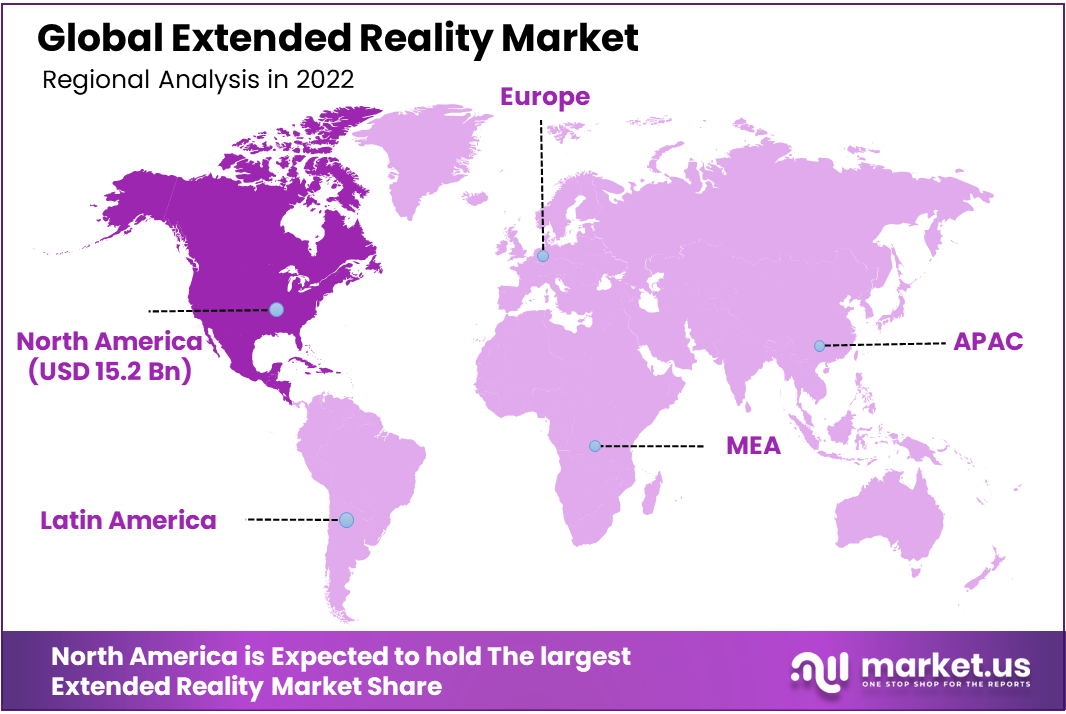
AR Market Size and Growth
- The augmented reality (AR) market has exhibited substantial growth over the years, with notable expansion in market size. In 2017, the AR market was valued at approximately USD 3.48 billion.
- The following year, in 2018, it experienced a significant surge, reaching USD 5.91 billion, reflecting a remarkable year-over-year increase.
- Looking ahead to 2025, the AR market is poised for a substantial transformation. With a projected market size of USD 198.17 billion.
- This phenomenal growth underscores the increasing integration of AR technology across various industries. The rising demand for augmented reality experiences among consumers and businesses alike.
(Source: Statista)
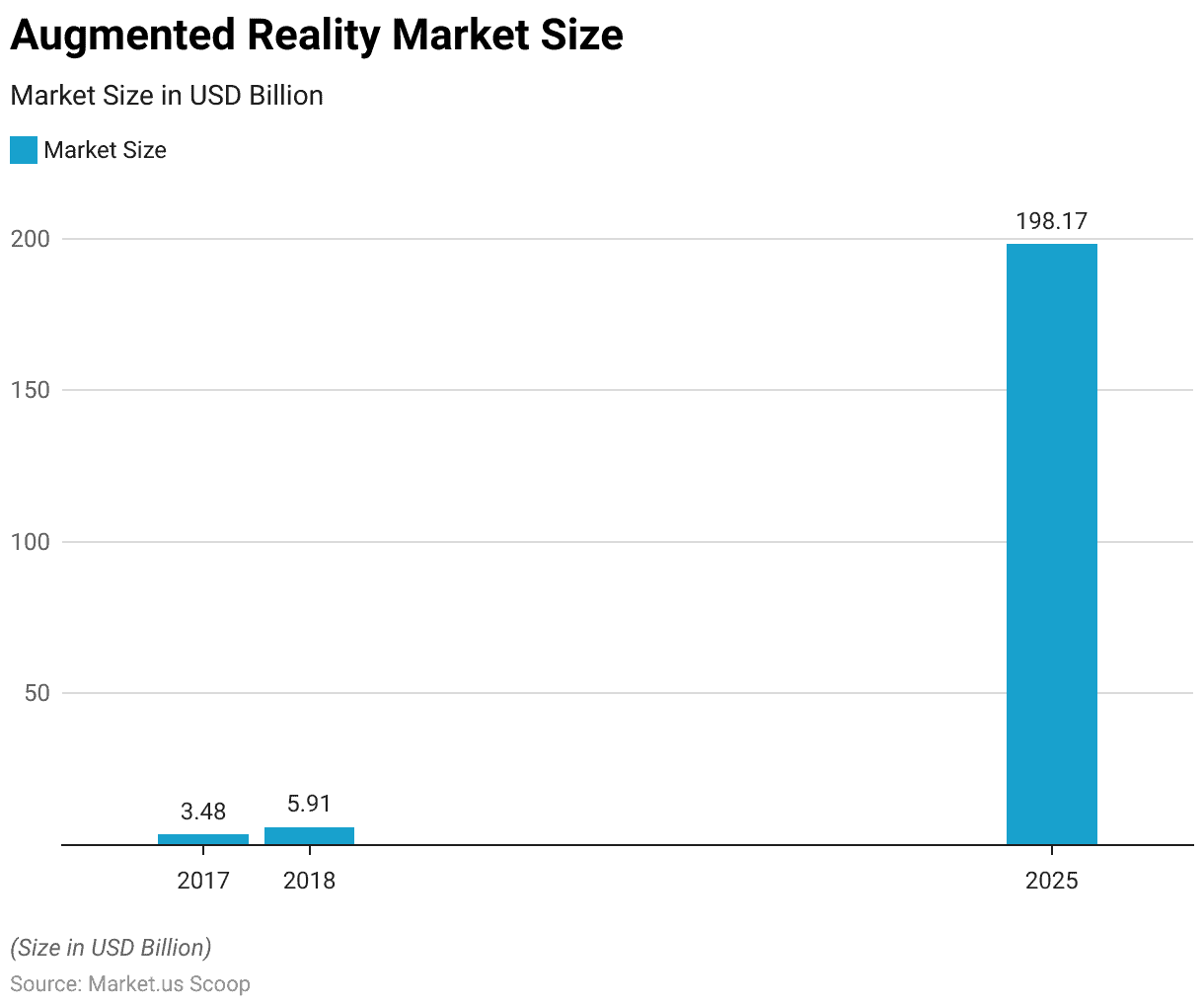
Top AR Companies
- Apple is leading the pack with an impressive revenue of $274.5 billion, boasting the world’s largest AR platform. Featuring hundreds of millions of AR-capable devices and an extensive catalog of over a thousand AR apps on the App Store.
- In second place, with a substantial revenue of $143 billion, is Microsoft. A prominent Washington-based tech giant that has also made substantial strides in the AR market.
- Niantic is recognized for developing the mobile AR sensation Pokémon Go. Takes another notable spot, accumulating a substantial $2 billion in revenue through in-app purchases. Besides Pokémon Go, Niantic has created other noteworthy mobile AR games like Ingress Prime and Harry Potter: Wizards Unite.
- Amazon also appeared, notably in 2017, when Amazon Web Services (AWS) introduced Amazon Sumerian. A managed service that simplifies the creation of VR, AR, and 3D applications and games.
- Conversely, Alibaba entered the AR arena by launching Taobao Buy in 2018—an app that enhances the online shopping experience with interactive elements. This app is compatible with Microsoft’s HoloLens headsets. This enables users to browse and interact with a curated selection of products from Alibaba’s online store.
(Source: AI Magazine)
Virtual Reality (VR) Statistics
- The virtual reality (VR) Market is experiencing rapid growth, with projections indicating that the global VR market size will expand. Significantly, going from under 12 billion U.S. dollars in 2022 to over 22 billion U.S. dollars by 2025.
- In 2022, the revenue from consumer and enterprise VR was 11.97 billion US dollars, reflecting an increase previous year.
- 2023 VR earnings are expected to increase, with predictions reaching 15.81 billion US dollars.
- The market is witnessing an influx of new VR headsets. Notable suppliers of VR headsets include Pico, Sony, and Meta.
- In June 2023, Mark Zuckerberg unveiled Meta’s next-generation VR and mixed-reality headset, the Meta Quest 3.
- Apple also entered the immersive technology arena by introducing its inaugural product. The Apple Vision Pro, at the June 2023 Worldwide Developers Conference (WWDC). This device allows users to seamlessly transition from augmented reality (AR) to VR experiences with a simple turn of a dial. However, Apple’s foray into extended reality comes at a premium price with the Apple Vision.
- Pro set to retail for 3,499 U.S. dollars upon its release—significantly higher than Meta’s Quest Pro and Quest 3, priced at 999 U.S. dollars and 499 U.S. dollars, respectively.
(Source: Statista)
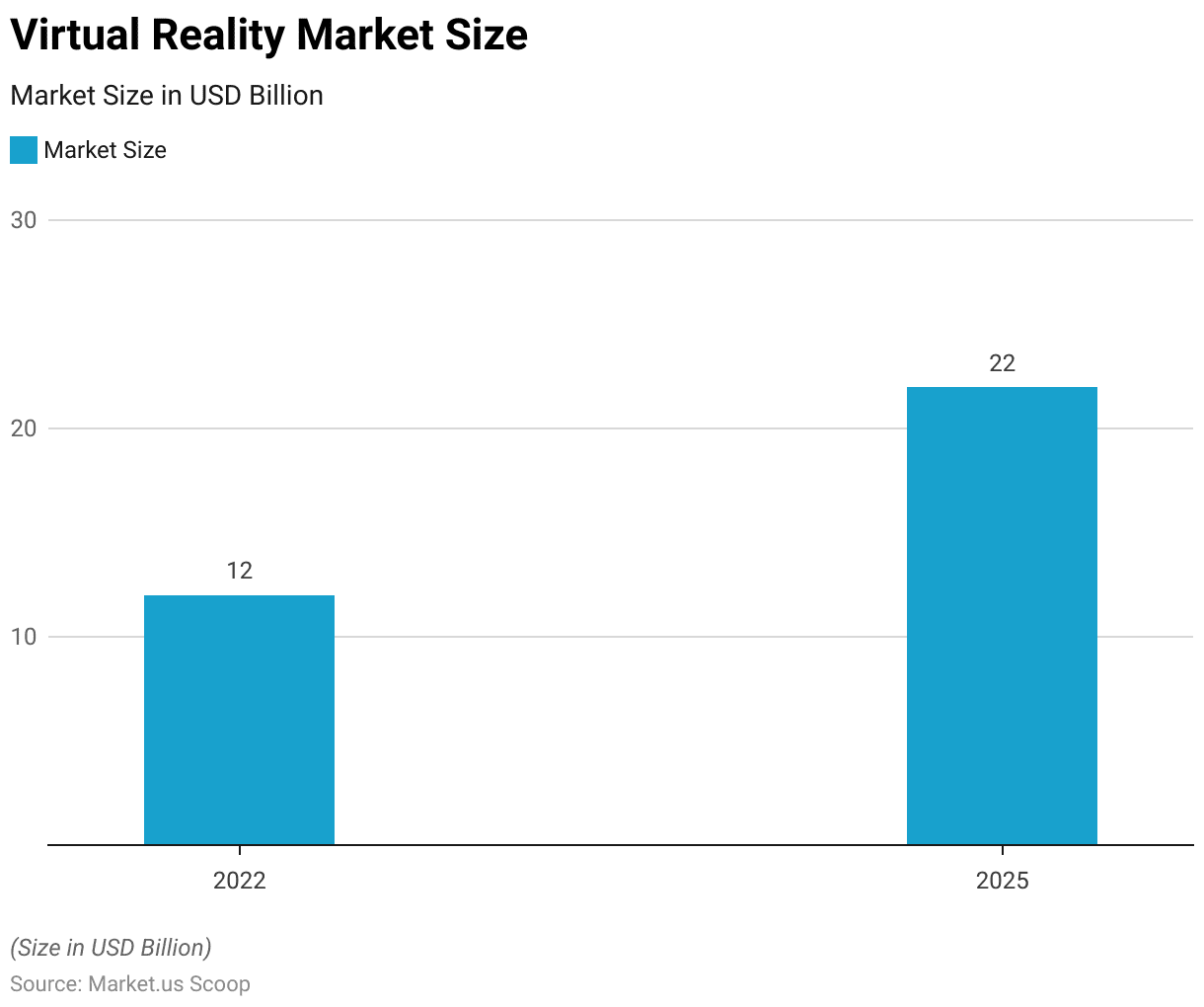
Mixed Reality (MR) Statistics
- The mixed reality (MR) market has rapidly surged, with its worth skyrocketing from $1.2 billion in 2020 to a projected $20.4 billion by 2026.
- This remarkable growth surpasses that seen in both augmented reality (AR) and virtual reality (VR) markets, emphasizing the substantial potential of MR technology.
- In 2021 alone, MR startups and established firms garnered over $2 billion in funding, reflecting strong confidence in MR’s future.
- Globally, MR users are expected to exceed 75 million by 2024, driven by MR hardware and software advancements and increased recognition of its benefits in consumer and business applications.
- Diverse industries, such as healthcare, education, entertainment, and manufacturing, are adopting mixed reality.
- Additionally, sales of MR headsets are on the rise, with an estimated 11.3 million units projected to be sold by 2025.
- Leading providers in this arena include Microsoft with HoloLens and Magic Leap.
- User satisfaction and engagement with mixed reality experiences are high, with 67% of users reporting positive interactions.
(Source: Capsule Insights)
Extended Reality Statistics by Gaming Sector
- The XR gaming market will be worth $18 billion by 2023.
- The revenue generated from virtual reality gaming has displayed a consistent upward trajectory in recent years. In 2019, it stood at 0.5 billion U.S. dollars and witnessed a notable increase to 0.9 billion U.S. dollars in 2020.
- The momentum continued into 2021, with revenues climbing to 1.4 billion U.S. dollars.
- As of 2022, virtual reality gaming revenue further expanded to 1.8 billion U.S. dollars, and it is projected to continue its growth. Reaching 2.5 billion U.S. dollars in 2023 and 3.2 billion U.S. dollars in 2024.
(Source: ALP Consulting, Statista)
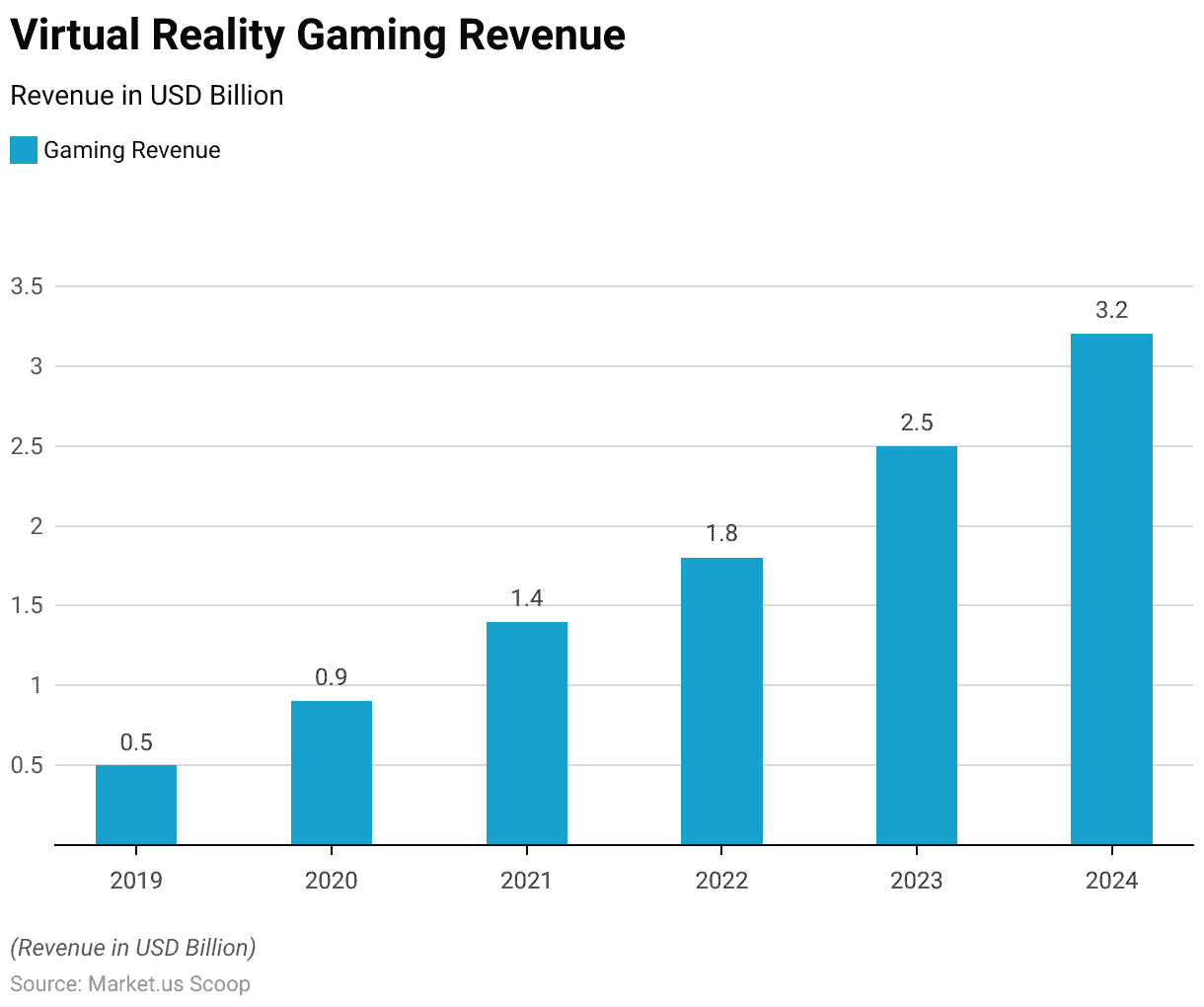
Extended Reality in Healthcare Statistics
- Projections indicate that the worldwide digital healthcare sector will surpass a value of $430 billion by the year 2028.
- Findings from a study conducted by Imperial College London reveal that 83% of individuals trained using virtual reality (VR). This could independently perform spinal surgery with minimal assistance. In stark contrast to the 0% success rate among those who received traditional training.
- Furthermore, VR therapy has demonstrated its effectiveness in alleviating chronic pain and received authorization from the FDA in 2021.
- Research also indicates that in 2021, 72% of internet users turned to search engines to seek health-related information.
- Based on a 2020 survey, 68% of experts in the extended reality (XR) industry predict training simulations. This will emerge as a prominent use of immersive technologies in healthcare over the coming two years.
- The anticipated expansion of the augmented reality (AR) healthcare market is poised to generate revenues totaling $10 billion. While the virtual reality (VR) healthcare market is expected to reach $1.2 billion by 2024.
More Insights
- In the UK’s home-use market, The Times reported a substantial 350% increase in the sales of VR headsets in January 2021. As people confined to their homes sought a safe means of escape from lockdowns.
- According to Ofcom, one in 17 UK households owned a VR headset at the beginning of the previous year, up from one in 20 in 2018.
- The application of extended reality (XR) can assist patients in confronting surgeries and treatments they might otherwise avoid, potentially leading to annual savings of £2 million.
- Delivering therapies remotely through VR can be 2-3 times more cost-effective, Than traditional rehabilitation, reducing wait times, enhancing engagement, and lowering the risk of symptom exacerbation.
- Additionally, XR can reduce training costs and significantly improve surgical performance. Boasting a potential increase of up to 230% compared to conventional training methods.
(Source: “Virtual Reality in Healthcare – a Study on VR Surgery”- VRDirect, Research.ai.multiple.com, “Virtual reality for chronic pain relief”- Harvard Health Publishing, “Inspiring Ways Healthcare Marketing is Using Augmented Reality.” – 10TH DEGREE, Statista, XRHealthuk.org)
Extended Reality in Education Statistics
- Findings from a study by the National Education Association indicate that traditional lectures result in a meager 5% learning retention rate while reading materials yield slightly better at 10%.
- Surprisingly, virtual reality (VR) boasts an impressive learning retention rate of 75%. This is attributed to its capacity to enhance learning through immersive technology, making it significantly more engaging.
- According to reports from News Direct, five higher education programs in the United States, including Colorado State University’s Clapp Lab and Florida International University. Embracing extended reality (XR) technologies to revolutionize college students’ learning experiences.
(Source: ALP Consulting)
Retail and E-commerce Extended Reality Statistics
- Projections suggest that by 2024, approximately 1.73 billion mobile users will actively engage with augmented reality (AR) technology.
- A significant 70% of consumers believe that AR has the potential to offer them valuable advantages.
- Furthermore, 57% of shoppers are more inclined to purchase from brands incorporating AR.
- When comparing AR-powered eCommerce experiences to those without AR, the former is twice as engaging, with a 200% increase in user engagement.
- Surprisingly, despite its evident benefits, only 15% of online retailers have integrated AR into their operations.
- According to an AR consumer survey conducted by Google, 66% of individuals express a keen interest in utilizing augmented reality technology to aid their shopping experiences.
- Research conducted with Facebook’s AR collaborator, Vertebrae, reveals that retailers who have embraced AR during the COVID-19 pandemic observe a substantial 19% uptick in customer engagement.
- Furthermore, there’s a remarkable 90% increase in customer conversion rates for those who actively interact with AR compared to those who do not.
- Shopify, an eCommerce platform, asserts that products featuring VR/AR content in their advertisements witness an impressive 94% higher conversion rate than those lacking such content.
- Deloitte suggests that 40% of shoppers would be willing to pay a premium for a product if they could test it through AR technology.
(Source: TechJury, XR today, ThreeKit, Kommando Tech, Google Consumer AR Survey, Global, 2019, Vertebrae, Shopify, Deloitte)
Extended Reality in Real Estate Statistics
- Virtual staging is used by 8 out of 10 real estate agents to assist potential customers. These virtual property tours assist buyers in understanding the worth of the property.
- Goldman Sachs predicts that the VR and AR sectors in the real estate industry will reach a market value of $80 billion by 2025.
- According to Goldman Sachs, around 1.4 million registered real estate agents utilize VR technology to assist potential clients. Resulting in a combined market for real estate commissions valued at $107 billion. The same report underscores that the value proposition of VR home listings surpasses that of online advertisements by a significant margin.
- Furthermore, findings from a survey conducted by VRARA reveal that panoramic tours play a substantial role in the purchasing decisions of 40.4% of apartment buyers. An impressive 72.7% of clients who have experienced panoramic tours expressed positive feedback about this tool.
- Additionally, 64.4% of apartment buyers confirm that using 3D and VR content greatly helps them accurately gauge the size and dimensions of the rooms in the properties they are considering.
(Source: Ruahtech.com, Goldman Sachs, VRARA)
Extended Reality Statistics Latest Technology Trends
- In the realm of XR headset providers, we find familiar names such as Sony, Oculus, and HTC offering a range of VR devices.
- On the other hand, companies like Microsoft, Vuzix, and Magic Leap specialize in AR headsets and glasses.
- Qualcomm and LG lead the way regarding ownership of XR patents.
- Qualcomm, in collaboration with 15 telecommunications providers from across the globe. Formed the Global XR Content Telco Alliance in a joint effort to advance 5G-based AR/VR content.
- Notably, as of 2020, the United States boasts 841 registered extended reality patents, while Japan has filed 687 XR patents, and the World Intellectual Property Organization has registered 502 XR patents.
- In a 2019 report, it was predicted that the influence of VR and AR technologies would extend to over 23 million jobs worldwide by 2023. Representing a significant surge from 800,000 jobs in 2019.
(Source: ThriveMyWay)
Recent Developments
Acquisitions and Mergers:
- Facebook (Meta) acquires BigBox VR: In 2023, Meta (formerly Facebook) acquired BigBox VR, a developer of popular VR games, for $500 million. This acquisition aims to enhance Meta’s VR content offerings and support its vision for the metaverse.
- Qualcomm acquires Augmented Pixels: Qualcomm acquired Augmented Pixels, a company specializing in 3D mapping and AR technologies, in late 2023 for $250 million. This merger is expected to bolster Qualcomm’s XR platform capabilities.
New Product Launches:
- Apple AR/VR Headset: Apple launched its long-awaited AR/VR headset, Apple Vision, in early 2024. The device features advanced optics, high-resolution displays, and integration with Apple’s ecosystem, targeting both consumer and enterprise markets.
- Microsoft HoloLens 3: Microsoft introduced the HoloLens 3 in mid-2023, with improved performance, better ergonomics, and enhanced mixed reality capabilities for industrial and educational applications.
Funding:
- Magic Leap raises $500 million: In 2023, Magic Leap secured $500 million in funding to continue developing its AR technology and expand its enterprise solutions, particularly in healthcare and manufacturing.
- Niantic raises $300 million: Niantic, known for its AR game Pokémon GO, raised $300 million in early 2024 to develop its AR platform and create new AR experiences for mobile users.
Technological Advancements:
- AI and Machine Learning in XR: Integration of AI and machine learning is enhancing XR experiences by enabling more realistic interactions, dynamic content generation, and improved user engagement.
- 5G-Enabled XR Devices: The rollout of 5G technology is significantly enhancing XR experiences by providing faster data transfer rates and lower latency, essential for seamless AR and VR applications.
Market Dynamics:
- Growth in XR Market: The global XR market is projected to grow at a CAGR of 28% from 2023 to 2028, driven by increasing adoption in gaming, healthcare, education, and retail sectors.
- Adoption in Healthcare: XR is being increasingly adopted in healthcare for applications such as surgical simulations, patient education, and mental health therapy, with significant investments in XR health technologies.
Regulatory and Strategic Developments:
- Data Privacy and Security Regulations: With the rise of XR technologies, there is a growing focus on data privacy and security regulations to ensure user data is protected and XR experiences are secure.
- Interoperability Standards: Industry groups are working on establishing interoperability standards for XR devices and platforms to ensure seamless integration and communication across different systems.
Research and Development:
- Advancements in Haptics: R&D efforts are focusing on enhancing haptic feedback in XR devices to provide more immersive and tactile experiences, allowing users to feel virtual objects and environments.
- Spatial Computing: Researchers are advancing spatial computing technologies, enabling XR devices to better understand and interact with the physical world, enhancing the realism and usability of XR applications.
Conclusion
Extended Reality Statistics – The Extended Reality (XR) landscape, comprising Augmented Reality (AR), Virtual Reality (VR), and Mixed Reality (MR), has witnessed significant growth across diverse industries.
The XR market shows continuous expansion, driven by technological advancements, while AR finds applications in healthcare, retail, and gaming, and VR gains traction in education, training, and entertainment.
XR is no longer confined to niches, with consumers and enterprises integrating XR solutions for productivity, learning, and engagement.
The dynamic content creation field pushes boundaries, but ethical, regulatory, and safety concerns demand attention.
With ongoing technological advancements and increased connectivity, the future of XR holds vast potential to reshape how we interact with digital information and reality itself, necessitating responsible innovation and collaboration across industries and sectors.
FAQs
Extended Reality, or XR, is an umbrella term that encompasses Augmented Reality (AR), Virtual Reality (VR), and Mixed Reality (MR). XR technologies merge the digital and physical worlds to create immersive experiences.
The XR market has been growing rapidly in recent years. Growth rates vary by segment, with AR, VR, and MR all showing substantial expansion, driven by technological advancements and increasing adoption across industries.
XR technologies are finding applications across a wide range of industries. The most prominent sectors include healthcare, education, gaming, retail, manufacturing, and entertainment.
Critical drivers of XR adoption include improved hardware capabilities, enhanced content creation, increased awareness and demand, and a growing need for immersive training and collaboration solutions.
XR poses challenges related to data privacy, as it often involves collecting and processing user information. Safety concerns include potential health issues like motion sickness in VR and physical safety when using AR in real-world environments.
Discuss your needs with our analyst
Please share your requirements with more details so our analyst can check if they can solve your problem(s)



